Support SHS Students Through the PTA Scholarship Fund
- Details
- Written by: Joanne Wallenstein
- Hits: 218
 SHS PTA Scholarship Fund for College
SHS PTA Scholarship Fund for College
The Scarsdale High School PTA Scholarship Fund for College helps to defray freshman-year tuition costs for students in need of financial assistance by providing grants to graduating Scarsdale seniors for their freshman year of college.
Every Scarsdale household recently received an appeal to support the Scarsdale High School PTA Scholarship Fund for College. While our community is generally one of means, there are families here affected by hardship, such as illness, divorce, and business collapse, which can have devastating effects on a family’s ability to pay for college education. We expect student needs to be significant again this year.
The Fund is administered under strict rules of confidence, and all money raised directly benefits qualified students. Scholarship funding comes solely from donations by Scarsdale residents, businesses, PTC, PTA’s and other local organizations.
You can learn more about and donate to the SHS PTA Scholarship Fund for College by visiting https://shs.scarsdaleschools.org/scholarship. Donations, which are tax-deductible, may also be mailed to Scarsdale High School PTA Scholarship Fund for College, 1057 Post Road, Scarsdale, NY 10583. Please contact Lauren Grossberg at [email protected] with any questions.
Thank you in advance for your support!
5K Run to Support Meals on Wheels, December 14
- Details
- Written by: Joanne Wallenstein
- Hits: 1093
Ethan Grossberg, Scarsdale High School junior, and Becca Friedland, SHS sophomore, were inspired by the work their moms were doing to reinvigorate Meals on Wheels Scarsdale, so they decided to form the first ever Meals on Wheels Scarsdale Junior Board. The board began its work in early 2025 with the goal of enhancing the meal delivery experience for all meal recipients. Between birthday bags and Thanksgiving baskets, they continue to brainstorm and execute ways to bring a smile to the faces of the MOW recipients.
In order to bring their ideas to life, the junior board, which also includes Ayla Kantor, Lila Rosen, Hunter Ross and Ryan Sussberg knew they would need to do some fundraising. Becca and Ethan came up with the idea to organize a 5K race in Scarsdale to help raise money to cover the costs of the junior board initiatives, as well as have additional dollars to keep Meals on Wheels running effectively. The first ever Meals on Wheels Frosty 5K is scheduled for December 14th at 10:00 am at Scarsdale High School. We hope Scarsdale residents will register to come support this special, and very necessary, organization. People can run, walk, come alone, bring a friend, come as a family...however they want, we just hope to see them there! See the link and flyer for registration information.

Scarsdale Students Post Strong Results as District Expands Performance-Based Assessments
- Details
- Written by: Wendy MacMillan
- Hits: 1121
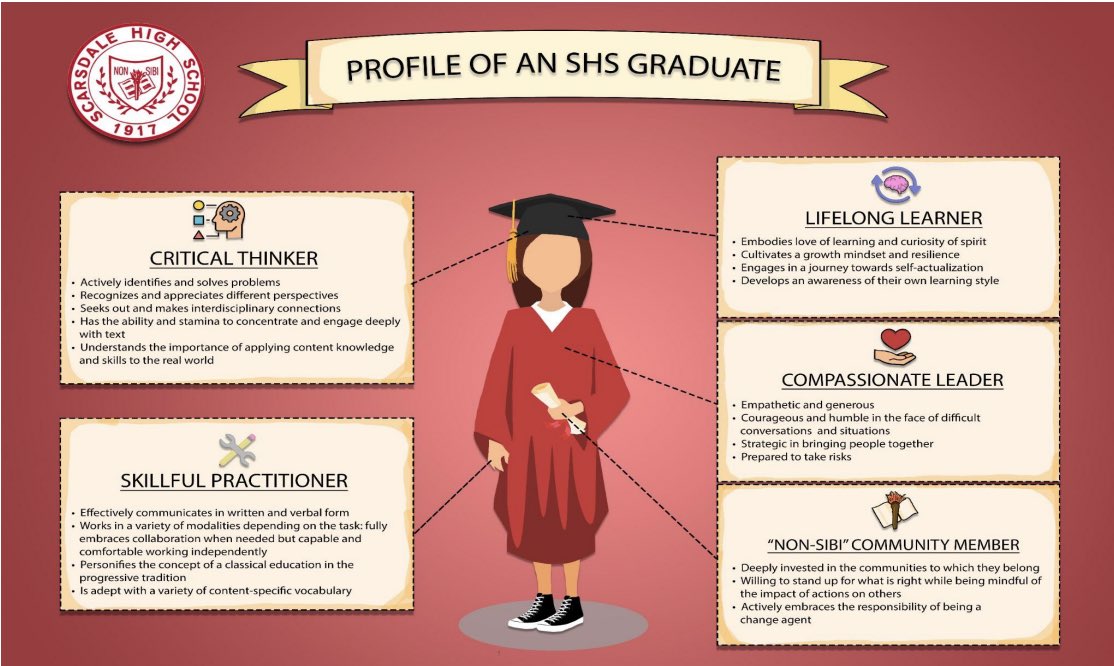 Scarsdale students continue to demonstrate high academic achievement across standardized measures, according to an annual assessment report presented to the Board of Education on Monday November 18th. In his three-part report, Assistant Superintendent of Curriculum, Dr. Edgar MacIntosh also outlined findings from a recent Tri-State Consortium review that praised the district’s instructional practices and recommended further expansion of performance-based assessments.
Scarsdale students continue to demonstrate high academic achievement across standardized measures, according to an annual assessment report presented to the Board of Education on Monday November 18th. In his three-part report, Assistant Superintendent of Curriculum, Dr. Edgar MacIntosh also outlined findings from a recent Tri-State Consortium review that praised the district’s instructional practices and recommended further expansion of performance-based assessments.
College Readiness Indicators Remain Strong
Dr. MacIntosh reported near-universal college enrollment among Scarsdale High School graduates, consistent with previous years. For tracking admissions trends, the district now uses the U.S. News & World Report lists of top universities and liberal arts colleges after the Barron’s “Most Competitive Colleges” index ceased regular publication. A slide shared during the presentation showed that in 2025, 69% of Scarsdale graduates went on to attend one of U.S News designated top 50 colleges or universities. MacIntosh includes a complete list of these colleges in his presentation’s supporting documents.

Also consistent with previous years, Scarsdale students recorded high mean scores on both the SAT and ACT. Furthermore, these results showed that an overwhelming percentage of students meet College Readiness Benchmarks, indicating readiness for first-year college coursework. Comparisons with other high-performing local districts show Scarsdale students maintaining a leading position.
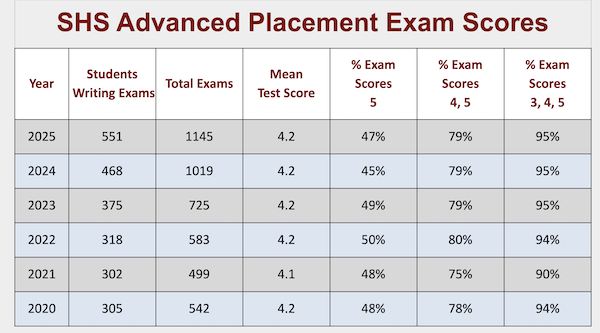
MacIntosh went on to describe that AP exam participation by Scarsdale students continues to rise, including among younger students. Administrators have suggested that some families may believe AP testing strengthens college applications, though college admissions officers have not indicated that AP scores provide an advantage. Board members asked for additional data on test-taking patterns and potential implications for college credit or placement.
State Testing Results Show Consistent Performance
Scarsdale elementary and middle school students continued to outperform statewide, regional, and other high performing-peer districts averages on New York State assessments in English language arts, mathematics, and science. MacIntosh cautioned that year-to-year variation between Scarsdale’s elementary schools is typical and influenced by cohort size and student needs. He also noted that a statewide increase in ELA scores this year was attributed to changes in the exam, not to the shift toward computer-based testing.
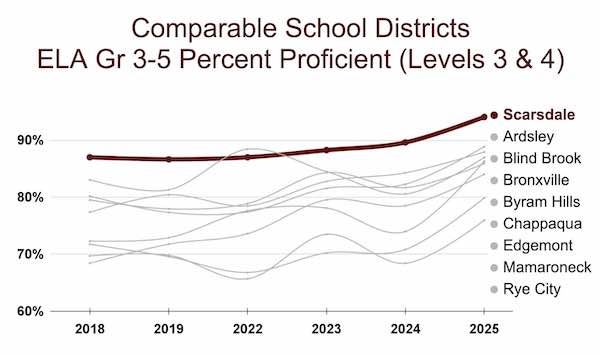
Regents exam results at the high school level also reflected incredibly strong proficiency across core subjects.
You can see all the data presented in the slideshow here.
While the district acknowledged the role of standardized exams in providing broad measures of student achievement, MacIntosh made sure to emphasize that these assessments offer only a “small portion” of the district’s overall approach to evaluating student learning. He added that internal benchmark assessments, progress monitoring, formative tools, and performance-based tasks offer a more detailed and actionable picture.
Tri-State Review Affirms District Practices
The Tri-State Consortium, a collaborative of high-performing districts, conducted an in-depth review of Scarsdale’s assessment system. After observing classrooms, interviewing stakeholders, and reviewing more than 300 teacher-created assessments, the team concluded that Scarsdale’s instructional practices align with the district’s strategic priorities.
Commendations included strong student engagement, widespread use of inquiry-based instruction, and extensive opportunities for student choice and authentic learning. Programs such as the Middle School Choice Program, STEAM pathways, and elementary science performance units were cited as aligned with district goals.
The consortium recommended that the district adopt a clear, shared definition of performance assessments; expand professional development on assessment design; address student stress related to grading and workload; and communicate more frequently with families about assessment practices.
Shift Toward Performance Tasks Gains Momentum
In his report, MacIntosh highlighted the growing use of performance-based assessments, which allow students to demonstrate understanding through open-ended, real-world tasks. A video shown during the meeting featured students and teachers describing project-based math problems, engineering design challenges, and interdisciplinary tasks that require collaboration, reasoning, and reflection.
Board members praised the student perspectives and asked how assessment practices intersect with the district’s ongoing facilities planning. MacIntosh related that flexible classroom spaces are increasingly important to support collaborative learning.
Next Steps
The district plans to incorporate the Tri-State recommendations into ongoing work around curriculum, assessment, and teacher professional learning. MacIntosh stated that the district’s goal is to maintain strong performance on standardized measures while expanding assessment practices that more accurately capture student thinking and real-world problem-solving. “Standardized tests give us one snapshot,” he said. “Our performance tasks show much more about how students learn.”
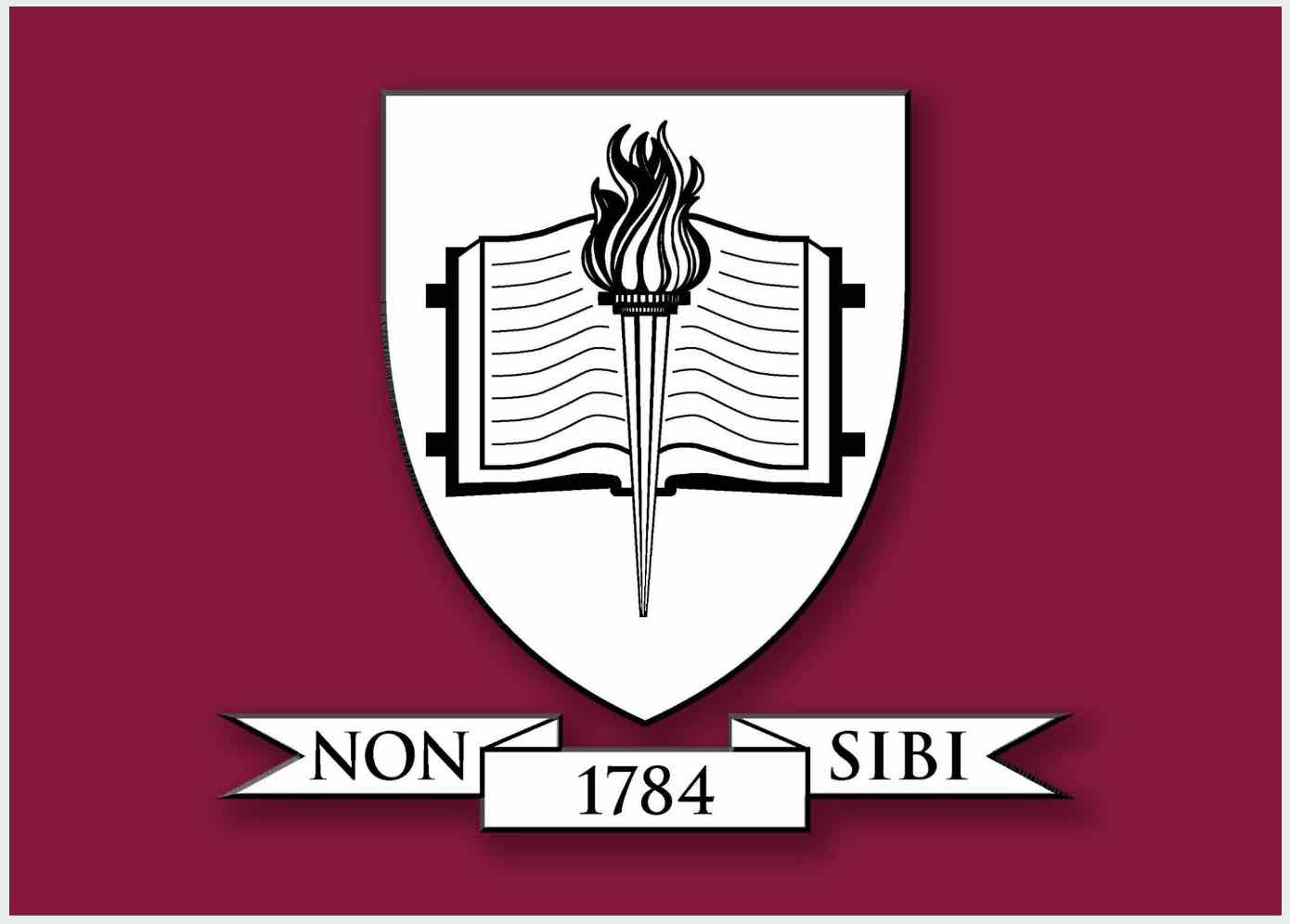
Westchester Consortium Wins Price Concessions from Con Edison
- Details
- Written by: Joanne Wallenstein
- Hits: 1043
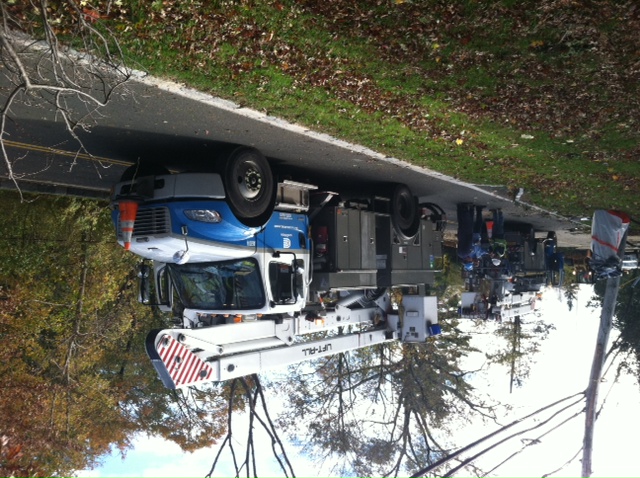 The Westchester Municipal Consortium (WMC) — an unprecedented coalition of 40 local municipalities that joined forces to become a party to Con Edison’s 2025 electric and gas rate case filings before the New York State Public Service Commission (PSC), announced that a three-year settlement agreement (known as a Joint Proposal) has been formally reached between Con Edison, the PSC staff, and other parties.
The Westchester Municipal Consortium (WMC) — an unprecedented coalition of 40 local municipalities that joined forces to become a party to Con Edison’s 2025 electric and gas rate case filings before the New York State Public Service Commission (PSC), announced that a three-year settlement agreement (known as a Joint Proposal) has been formally reached between Con Edison, the PSC staff, and other parties.
The terms of the filed agreement are now public and represent significant progress for Westchester residents and businesses in ensuring fairer and more transparent utility practices.
The Joint Proposal substantially reduces Con Edison’s original rate requests and includes several key provisions advanced by the Westchester Municipal Consortium. Because these provisions were successfully incorporated into the three-year settlement, the Consortium will not oppose the agreement. The Joint Proposal itself states: “The Westchester Municipal Consortium will also not oppose this negotiated Proposal, which substantially reduces the Company’s initial rate proposals and includes provisions sought by the Westchester Municipal Consortium.”
Settlement Includes Major Reductions in Originally Proposed Rates
Con Edison’s original proposed electric rate increase of 13.4% has been reduced to 2.8% on the total customer bill under the settlement. On the gas side, the original proposed 19% increase has been reduced to 2% on the total customer bill. The agreement spans January 1, 2026, through December 31, 2028, with similar annual increases of approximately 2.8% (electric) and 2.0% (gas) in the second and third years.
Key Westchester-Specific Provisions Secured
The Joint Proposal includes several items specifically negotiated by the Westchester Municipal Consortium to address longstanding disparities and improve communication and transparency:
• Annual Westchester Capital Investment Meetings
Con Edison leadership — including senior engineering and operations staff — will meet annually with Westchester municipalities to review capital project plans and compare investment levels in Westchester versus New York City. The meetings will also address storm preparedness, double-pole removal, streetlighting, and the impact of data centers on the local grid.
• Underground vs. Overhead Cost Analysis
Responding to WMC’s request, Con Edison agreed to conduct an informational analysis comparing the relative costs of its underground network system (predominant in New York City) and its overhead radial system (predominant in Westchester County and Staten Island). This study will help determine whether any cross-subsidization exists between regions and will be shared prior to the Company’s next rate filing.
“While the reductions do not go as far as we had proposed, they are a substantial move in the name of affordability, and the requirements for more disclosure and transparency on capital projects and the costs of overhead vs. underground systems are major gains for our County,” said Joel Dichter, Counsel for the Westchester Municipal Consortium. “This outcome reflects how much can be accomplished when Westchester’s municipalities stand together for a common goal.”
Next Steps and PSC Review
The Westchester Municipal Consortium will prepare and submit formal comments on the Joint Proposal to the Public Service Commission. The PSC will then conduct an evidentiary hearing to evaluate the settlement’s terms before issuing a final decision.
“There is no doubt that Westchester’s municipalities banding together had a substantial impact on the results,” said Hastings-on-Hudson Mayor Nicola Armacost, who is also President of the Westchester Municipal Officials Association. “This collaboration ensured our communities were heard at the state level and will continue to give us a voice in how utility investments are made in Westchester.”
About the Westchester Municipal Consortium
The Westchester Municipal Consortium (WMC) is composed of 40 unified municipalities throughout Westchester County that are served by Con Edison and came together to work collaboratively to ensure fair utility practices, equitable infrastructure investments, and transparent communication between local governments, the utility, and state regulators.
“This outcome represents meaningful progress for the residents of Scarsdale and for communities across Westchester County served by Con Edison,” said Scarsdale Mayor Justin Arest. “By coming together as a coalition of municipalities, we demonstrated the strength of a unified voice in advocating for fairer, more reasonable energy costs for our community.”
Become a Friend of the Scarsdale Library
- Details
- Written by: Joanne Wallenstein
- Hits: 417
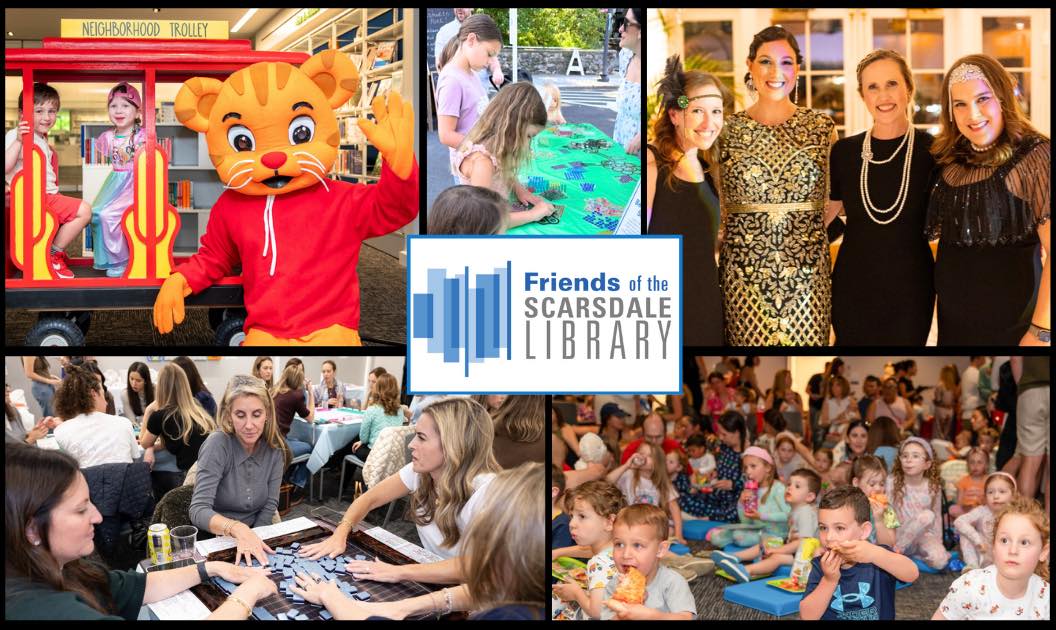 Dear Scarsdale Neighbor,
Dear Scarsdale Neighbor,
Imagine the joy of a child discovering the magic of books for the first time, a teen exploring technology and new ideas, or a senior connecting with neighbors through an afternoon concert at the library. These moments happen every day at the Scarsdale Public Library, and they happen because of you.
We invite you to become a Friend of the Scarsdale Public Library today. Your tax-deductible contribution helps keep our library a vibrant hub of inspiration, learning, and connection for the entire community.
Becoming a Friend is one of the simplest and most meaningful ways to give back to Scarsdale:
$75 helps spark imagination through children’s programming and educational activities
$250 supports thought-provoking author talks and cultural events
$500 and above sustains beloved community traditions like the summer concert series and family programs
Public funding covers part of what it takes to make our library thrive. The Friends of the Scarsdale Library (FOSL), a volunteer-driven nonprofit, fills that gap, ensuring access to innovative programs, free museum passes, and enriching experiences for all.
In 2024 alone, the Friends made possible 15 author events, 30 children’s programs, and 665 museum pass reservations to some of New York’s most celebrated cultural institutions. Your support directly fuels this impact.
From book talks to outdoor concerts, new technology to creative workshops, our library connects us all as neighbors, families, and generations. Together, we can ensure it continues to grow as the heart of Scarsdale for years to come.
Thank you for your generosity and for believing in the power of community. Please consider becoming a friend of the library today!
With gratitude,
Daniela Retelny and Toby Milstein Schulman
Co-Presidents, Friends of the Scarsdale Library
Payment can be made online or via check. If paying by check, please select the “check” option in the online form and send your check to:
Friends of the Scarsdale Library, Attn: Treasurer
54 Olmsted Rd, Scarsdale, NY 10583
- Please Recycle Your Pumpkins—It’s Easy!
- This Fall, Mow, Don’t Blow, Your Leaves: Better For Your Lawn and the Environment
- Shop and Contribute to Breast Cancer Awareness this Month at I Am More Scarsdale
- Assemblywoman Amy Paulin Introduces Bill to Protect New Yorkers’ Access to Vaccines Amid Federal Interference










